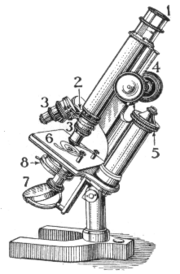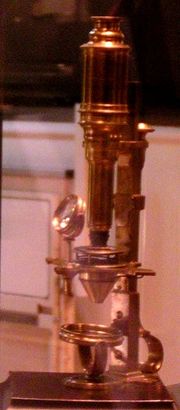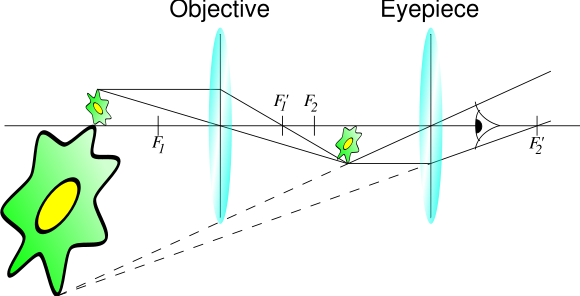Optical microscope
2007 Schools Wikipedia Selection. Related subjects: Engineering; General Physics
The optical microscope is a type of microscope which uses visible light and a system of lenses to magnify images of small samples. Optical microscopes are the oldest, simplest and.
Optical configurations
There are two basic configurations of optical microscope in use, the simple (one lens) and compound (many lenses).
Simple optical microscope
A simple microscope is a microscope that uses only one lens for magnification, and is the original light microscope. Van Leeuwenhoek's microscopes consisted of a single, small, convex lens mounted on a plate with a mechanism to hold the material to be examined (the sample or specimen). Demonstrations by British microscopist Brian J. Ford have produced surprisingly detailed images from such basic instruments. The use of a single, convex lens to magnify objects for viewing is found today only in the magnifying glass, the hand-lens, and the loup.
Compound optical microscope
The compound microscope uses a set of many lenses in order to maximize magnification. The diagram below shows a compound microscope. In its simplest form—as used by Robert Hooke, for example—the compound microscope would have a single glass lens of short focal length for the objective, and another single glass lens for the eyepiece or ocular. Modern microscopes of this kind are usually more complex, with multiple lens components in both objective and eyepiece assemblies. These multi-component lenses are designed to reduce aberrations, particularly chromatic aberration and spherical aberration. In modern microscopes the mirror is replaced by a lamp unit providing stable, controllable illumination.
History of the microscope
- See timeline of microscope technology.
It is impossible to say who invented the compound microscope. Dutch spectacle-makers Hans Janssen and his son Zacharias Janssen are often said to have invented the first compound microscope in 1590, but this was a declaration by Zacharias Janssen himself halfway through the 17th century. The date is certainly not likely, as it has been shown that Zacharias Janssen actually was born around 1590. Another favorite for the title of 'inventor of the microscope' was Galileo Galilei. He developed an occhiolino or compound microscope with a convex and a concave lens in 1609. Galilei's microscope was celebrated in the ´Lynx academy´ founded by Federico Cesi in 1603. Francesco Stelluti's drawing of three bees were part of pope Urban VIII´s seal, and count as the first microscopic figure published (see Stephen Jay Gould, The Lying stones of Marrakech, 2000). Christiaan Huygens, another Dutchman, developed a simple 2-lens ocular system in the late 1600's that was achromatically corrected and therefore a huge step forward in microscope development. The Huygens ocular is still being produced to this day, but suffers from a small field size, and the eye relief is uncomfortably close compared to modern widefield oculars.
Anton van Leeuwenhoek (1632-1723) is generally credited with bringing the microscope to the attention of biologists, even though simple magnifying lenses were already being produced in the 1500's, and the magnifying principle of water-filled glass bowls had been described by the Romans (Seneca). Van Leeuwenhoek's home-made microscopes were actually very small simple instruments with a single very strong lens. They were awkward in use but enabled van Leeuwenhoek to see highly detailed images, mainly because a single lens does not suffer the lens faults that are doubled or even multiplied when using several lenses in combination as in a compound microscope. It actually took about 150 years of optical development before the compound microscope was able to provide the same quality image as van Leeuwenhoek's simple microscopes. So although he was certainly a great microscopist, van Leeuwenhoek is, contrary to widespread claims, certainly not the inventor of the microscope.
The components of the microscope
All optical microscopes share the same basic components:
- The eyepiece or ocular - a cylinder containing two or more lenses to bring the image to focus for the eye. The eyepiece is inserted into the top end of the body tube. Eyepieces are interchangeable and many different eyepieces can be inserted with different magnifications. Typical values for eyepieces include X5, X10 and X20. In some high performance microscopes, the optics of the objective and eypiece are matched to give the best possible optical performance. This occurs most commonly with apochromatic objectives
- The objective lens - a cylinder containing one or more lenses to collect light from the sample. At the lower end of the microscope tube one or more objective lenses are screwed into a circular nose piece which may be rotated to select the required objective lens. Typical values of objectives are x5, x10, x20, x40, x80 and x100. Some high performance objectives may require matched eyepieces to deliver the best optical performance.
- The stage - a platform below the objective which supports the specimen being viewed. In the centre of the stage is a circular hole through which light shines to illuminate the specimen. The stage usually has arms to hold slides (rectangular glass plates with typical dimensions of 25mm by 75mm, on which the specimen is mounted).
- The illumination source - below the stage the light is provided and controlled in a variety of ways. At its simplest, daylight is directed via a mirror. Most microscopes, however, have their own controllable light source that is focused through an optical device called a condenser with diaphragms and filters available to manage the quality and intensity of the light.
In the classic microscope the whole of the optical assembly is attached to a rigid arm which in turn is attached to a robust U shaped foot to provide the necessary rigidity. The arm is usually able to pivot on its joint with the foot to allow the viewing angle to be adjusted. Mounted on the arm controls for focusing are usually placed, typically a large knurled wheel to control coarse focusing together with a smaller knurled wheel to control fine focusing.
More modern microscopes may have many more features, including transmission/reflection illumination, filters, apparatus for phase contrast microscopy and differential interference microscopy, digital cameras, etc.
Use of the microscope
Compound optical microscopes are typically used to examine a smear, a squash preparation, or a thinly sectioned slice of some material. With a few exceptions, they utilize light passing through the sample from below and special techniques are usually necessary to illuminate the sample to increase the contrast in the image to useful levels (see contrast methods). However, at low power they may also be used to examine small living animals and plants and even at high power, microscopic living speciments such as protozoa, rotifers, and bacteria may be examined.
A common use of non-transmitted lighting is to study the thin structure of metals (see metallography) and minerals, where the light is reflected from the examined surface. The light is fed down through the objective using a semi-transparent mirror, and the reflected light observed as normal.
Typically, on a standard compound optical microscope, there are three objective lenses: a scanning lens (5×), low power lens (10×) or sometimes medium power lens (20x), and high power lens (40×). Advanced microscopes often have a fourth objective lens, called an oil immersion lens. To use this lens, a drop of immersion oil is placed on top of the cover slip, and the lens is very carefully lowered until the front objective element is immersed in the oil film. Such immersion lenses are designed so that that the refractive index of the oil and of the cover slip are closely matched so that the light is transmitted from the specimen to the outer face of the objective lens with minimal refraction. An oil immersion lens usually has a power of 100×. Older microscopes were sometimes equipped with water immersion lenses which had a higher performance than non-immersion lenses but which were still significantly inferior in performance to oil immersion lenses.
The actual power or magnification of an optical microscope is the product of the powers of the ocular ( eyepiece), usually about 10×, and the objective lens being used.
Compound optical microscopes can produce a magnified image of a specimen up to 1000× and, at high magnifications, are used to study thin specimens as they have a very limited depth of field.
How a microscope works
The optical components of a modern microscope are very complex and for a microscope to work well, the whole optical path has to be very accurately set up and controlled. Despite this, the basic optical principles of a microscope are quite simple.
The objective lens is, at its simplest, a very high powered magnifying glass i.e. a lens with a very short focal length. This is brought very close to the specimen being examined so that the light from the specimen comes to a focus about 160 mm inside the microscope tube. This creates an enlarged image of the subject. This image is inverted and can be seen by removing the eyepiece and placing a piece of tracing paper over the end of the tube. By careful focusing a rather dim image of the specimen, much enlarged can be seen. It is this real image that is viewed by the eyepiece lens that provides further enlargement.
In most microscopes, the eyepiece is a compound lens, which is made of two lenses one near the front and one near the back of the eyepiece tube forming an air separated couplet. In many designs, the virtual image comes to a focus between the two lenses of the eyepiece, the first lens bringing the real image to a focus and the second lens enabling the eye to focus on the now virtual image.
In all microscopes the image is viewed with the eyes focused at infinity. Headaches and tired eyes after using a microscope are usually signs that the eye is being forced to focus at a close distance rather than at infinity.
Stereomicroscope
The stereo or dissecting microscope is designed differently from the diagrams above, and serves a different purpose. It uses two separate optical paths with two objectives and two eyepieces to provide slightly different viewing angles to the left and right eyes. In this way it produces a three-dimensional (3-D) visualization of the sample being examined.
The stereo microscope is often used to study the surfaces of solid specimens or to carry out close work such as sorting, dissection, microsurgery, watch-making, small circuit board manufacture or inspection, and the like.
Great working distance and depth of field here are important qualities for this type of microscope. Both qualities are inversely correlated with resolution: the higher the resolution (i.e., magnification), the smaller the depth of field and working distance. A stereo microscope has a useful magnification up to 100×. The resolution is maximally in the order of an average 10× objective in a compound microscope, and often much lower.
The stereo-microscope should not be confused with ordinary compound microscopes equipped with a binocular eyepieces. In these microscopes both eyes can see the image but the binocular head provides greater viewing comfort and slightly better appearance of resolution. However the image in such microscopes remains monocular.
Special designs
Other types of optical microscope include:
- the inverted microscope for studying samples from below; useful for cell cultures in liquid;
- the student microscope designed for low cost, durability, and ease of use;
- the research microscope which is an expensive tool with many enhancements;
- the petrographic microscope whose design usually includes a polarizing filter, rotating stage and gypsum plate to facilitate the study of minerals or other crystalline materials whose optical properties can vary with orientation.
- the polarizing microscope
- the fluorescence microscope
- the phase contrast microscope
Limitations of light microscopes
Compound optical microscopes are limited in their ability to resolve fine details by the properties of light and the refractive materials used to manufacture lenses. A lens magnifies by bending light (see refraction). Optical microscopes are restricted in their ability to resolve features by a phenomenon called diffraction which, based on the numerical aperture (NA or AN) of the optical system and the wavelengths of light used (λ), sets a definite limit (d) to the optical resolution. Assuming that optical aberrations are negligible, the resolution (d) is given by:
Usually, a λ of 550 nm is assumed, corresponding to green light. With air as medium, the highest practical AN is 0.95, and with oil, up to 1.5.
Due to diffraction, even the best classic optical microscope is limited to a resolution of 0.2 micrometres.
Optical microscopes have a focal point, either chosen or fixed, where the image is clear. This covers a two-dimensional area only. A single optical image cannot capture all the details of a three-dimensional shape in focus. Other types of microscopes are capable of imaging three-dimensional shapes.






